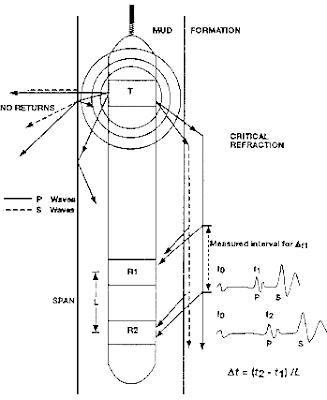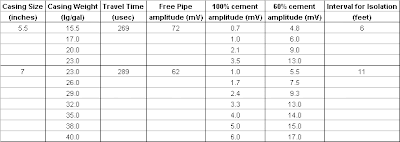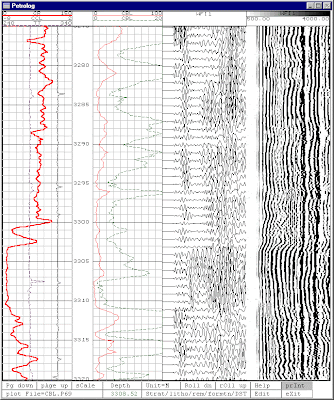CBL LOG
CBL RECORD HISTORY
* Registration CBL (REGISTRATION OF ADHESION OF CEMENT OR CEMENT BOND LOG) has been used since the 1960′s. It is still widely used and often preferred to many other instruments most recent assessment of cement.
* In mid-1980 ultrasonic transducer tools were introduced as the CET and PET tools.
CBL REGISTRATION APPLICATIONS
Among the varied applications of CBL registration are:
* Determine the quality of the cement bond between the cement and casing as well as between the cement and training to the isolation zone.
* Correlate with open hole logs (open hole logs) with cased-hole logs (cased hole logs) using the Casing Collar Locator (CCL) and Gamma Ray tool.
* An indication of the compressive strength of concrete. These tools (CET, PET) also measure the thickness of casing, micro ring and cement pipe, but no concrete measure revenue to training.
MEASUREMENT OF THE REGISTRATION THROUGH CBL
CBL Registry Operation
A cement bond log (CBL) is executed for inspecting the integrity of the sealing cement sheath and formation. This will ensure that formation fluids flow into the housing when the productive zone is perforated and not towards the outside of the casing.
CBL tool is similar in operation to the tool Sonic (sonic tool) to open hole. It consists of a transmitter and two receivers at distances of 3 and 5 feet from the transmitter. As with the Sonic tool compressional waves or P waves are used to measure the travel time from transmitter to receiver. CBL tool is not compensated unlike Sonic tool to open hole. The centralization of the CBL is essential to its operation. To this end, a centralized Gemoco OD to match the inside diameter of the housing must always be in the CBL tool.
Signal 3-foot (3-foot signal) from the sender to the receiver first, mainly measured the adhesion of cement to casing. If there is little or no link, the signal amplitude becomes larger. If there is good adhesion, the amplitude is very small. This is commonly known as the TT3 (Travel time 3 feet) or signal CBL (CBL Register Adhesion of cement).
A similar compression wave is measured with the 5-foot signal from the transmitter to the second receiver. The signal yet read deeper into the formation. Predominant measure the adhesion of cement to the training. As for the TT3, a large amplitude wave indicate poor adhesion while the opposite amplitude. Commonly known as the TT5 (Travel time from 5 feet) or signal VDL (Variable Density Log VDL).
CBL CALIBRATION
The pit should have fluid in the well to the acoustic coupling to occur.
SAMPLE PROFILE CBL (CBL LOG SAMPLE)
PROFILE PRESENTATION CBL (CBL REGISTRATION – CBL LOG)
CBL presentation has not changed in years. In the above image:
Track 1:
* The measure Gamma Ray correlation in open holes.
* The CCL (Magnetic Collar Locator) that highlights the peaks of each casing.
* Travel time TT3 as the size of the casing.
Track 3:
* Size of CBL (3 feet) in mV. For low amplitudes (better adherence of the cement), 0-20mV curves fit on the screen for accurate measurement.
Track 4:
* TT5 signal is displayed in a signature presentation. This shows the whole wave train.
Track 5:
* TT5 signal is shown in the pseudo-standard presentation of VDL. This is a “bird’s eye view”of the wave TT5 ‘on’the threshold.
The purpose of interpreting the CBL registration is to ensure the isolation of a good area for productive training. When you view the log presentation CBL qualitative analysis of the cement bond can be determined.












